The NVIDIA GeForce GTX 1070 Ti Founders Edition Review: GP104 Comes in Threes
by Nate Oh on November 2, 2017 9:00 AM EST- Posted in
- GPUs
- GeForce
- NVIDIA
- Pascal
- GTX 1070 Ti
Compute
Shifting gears, let’s take a look at compute performance on the GTX 1070 Ti.
As the GTX 1070 Ti is another GP104 SKU – and a fairly straightforward one at that – there shouldn’t be any surprises here. Relative to the GTX 1070, all of NVIDIA's performance improvements actually favor compute performance, so we should see a decent bump in performance here. However it won't change the fact that ultimately the GTX 1070 Ti will still come in below the GTX 1080, which has more SMs and a higher average clockspeed (never mind the benefits of more memory bandwidth).
Starting us off for our look at compute is Blender, the popular open source 3D modeling and rendering package. To examine Blender performance, we're running BlenchMark, a script and workload set that measures how long it takes to render a scene. BlechMark uses Blender's internal Cycles render engine, which is GPU accelerated on both NVIDIA (CUDA) and AMD (OpenCL) GPUs.
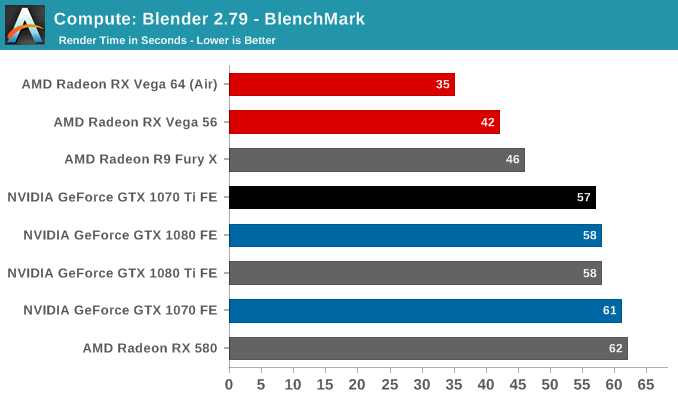
As you might expect, the GTX 1070 Ti's performance shoots ahead of the GTX 1070's due to the additional enabled SMs of this new video card SKU. In fact it technically outpaces the GTX 1080 by a single second, which although eye-popping, is within our margin of error. However what it can't do is overtake AMD's lead here, with the NVIDIA cards trailing the Vega family by quite a bit.
For our second set of compute benchmarks we have CompuBench 2.0, the latest iteration of Kishonti's GPU compute benchmark suite. CompuBench offers a wide array of different practical compute workloads, and we’ve decided to focus on level set segmentation, optical flow modeling, and N-Body physics simulations.
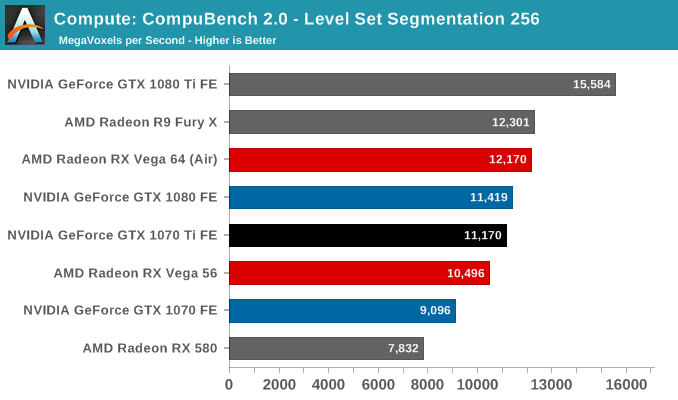

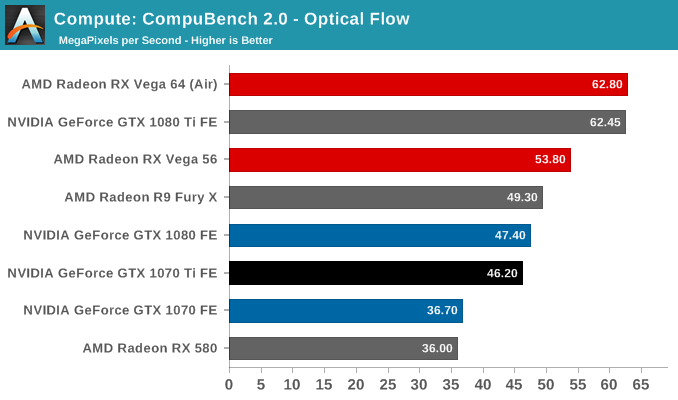
In all 3 sub-tests, the GTX 1070 Ti makes modest gains. Overall, performance is now quite close to the GTX 1080, which makes sense given the relatively small gap in on-paper compute performance between the two cards. This also means that at least in the case of these benchmarks, the lack of additional memory bandwidth isn't hurting the GTX 1070 Ti too much. However looking at the broader picture, all of the NVIDIA GP104 cards are trailing AMD's Vega family outside of the more equitable level set segmentation sub-test.
Moving on, our 3rd compute benchmark is the next generation release of FAHBench, the official Folding @ Home benchmark. Folding @ Home is the popular Stanford-backed research and distributed computing initiative that has work distributed to millions of volunteer computers over the internet, each of which is responsible for a tiny slice of a protein folding simulation. FAHBench can test both single precision and double precision floating point performance, with single precision being the most useful metric for most consumer cards due to their low double precision performance.
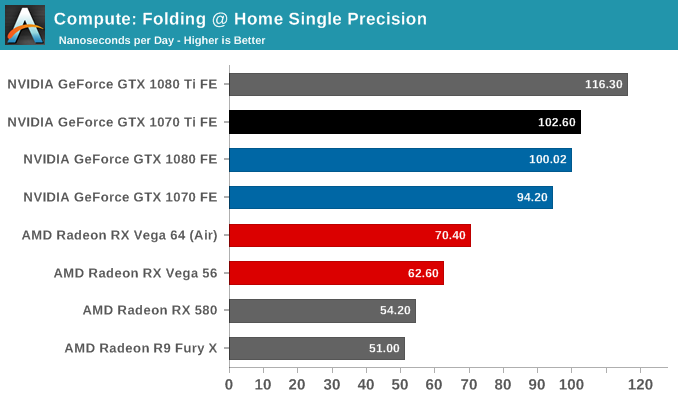
The GTX 1080 and GTX 1070 were already fairly close on this benchmark, so there's not a lot of room for the GTX 1070 Ti to stand out. Interestingly this is another case where performance actually slightly exceeds the GTX 1080 – though again within the margin of error – which further affirms just how close the compute performance of the new card is to the GTX 1080.
Our final compute benchmark is Geekbench 4's GPU compute suite. A multi-faceted test suite, Geekbench 4 runs seven different GPU sub-tests, ranging from face detection to FFTs, and then averages out their scores via their geometric mean. As a result Geekbench 4 isn't testing any one workload, but rather is an average of many different basic workloads.
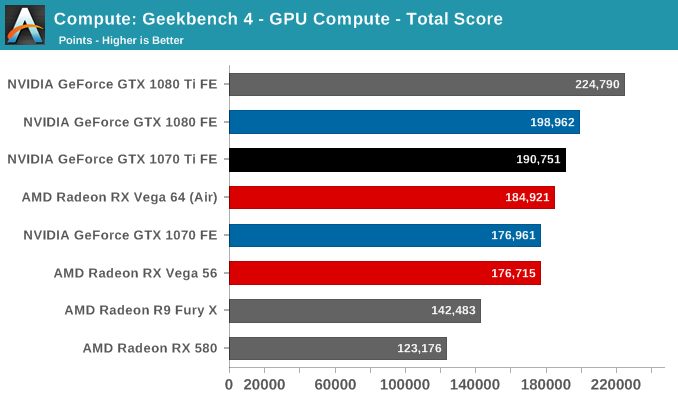
As with our other benchmarks, the GTX 1070 Ti more or less bridges the gap between the GTX 1080 and GTX 1070, falling just a few percent short of the GTX 1080 in performance. This is a test where NVIDIA was already doing better than average at, and now with its increased SM count, the GTX 1070 Ti has enough compute performance to surpass AMD's RX Vega 64, something the regular GTX 1070 could not do.










78 Comments
View All Comments
Destoya - Thursday, November 2, 2017 - link
I feel like you're ignoring cards like the 1050ti/1050 in order to better match your narrative. Both of those require no power connectors (75W TDP) and will reach 1080p60 easily for modern AAA games and 144 FPS on esports titles. Yes, both companies are making power hungry monster cards to satisfy high-end demand that get a lot of headlines, but the chip designs scale down incredibly well. Performance for low/mid-end systems has never been as good as it is now.The_Assimilator - Friday, November 3, 2017 - link
Yes yes, everybody should still be using teletype terminals and typewriters. Or even better, go back to scratching lines into cave walls with rocks, because that uses no power and creates no heat.Lord of the Bored - Friday, November 3, 2017 - link
Actually, it does create heat. Thermodynamics is a harsh mistress.catavalon21 - Thursday, January 10, 2019 - link
+1sonny73n - Friday, November 3, 2017 - link
Graphic and resolution mean the world to them because they have no life.theuglyman0war - Saturday, November 4, 2017 - link
I thought it was because God gave us two eyes that can see? ( the same reason I get my prescription glasses updated every year. Fidelity. )Is Lo Fi hip again?
Ranger1065 - Friday, November 3, 2017 - link
You should be removed ASAP dear Ciccio.TheJian - Thursday, November 2, 2017 - link
Bought mine at $499 (EVGA FTW2). Don't feel gouged at all. If it's gouging, they'd still be on the shelf. I'm guessing they'll be out of stock shortly. If they priced like you want, they'd have quarterly reports like AMD.. ROFL. That should not be the goal for NV, but rather to price as high as the market will accept...PERIOD. It is actually their JOB to do this.Sounds like you need to upgrade your job so you can afford better toys ;) AMD has lost $8B in the last 2 decades and looks like they only made money for a single quarter this time. They are predicting a down Q yet again (how can you have a bad xmas Q?) and just after all these launches. YOU ARE PRICING YOUR STUFF TOO LOW AMD!
bill.rookard - Thursday, November 2, 2017 - link
Well, that's not entirely accurate, AMD has had some nominally profitable quarters before this - not to the level of Intel for sure, but saying they've lost money every single quarter in the past 20 years is patently untrue. There were many times 'in the past two decades' when they were actually eating Intel's lunch, so enough of the hyperbole.Yes, they've not had an easy time since then, and have been in the dumps especially with their previous generation designs which, well, sucked. (caveat, the 8 core 8000 series actually did well on video encoding but that wasn't nearly enough)
As for pricing stuff too low? They HAVE to right now. Their issue is one of market share, and with their previous generation u-arch it couldn't remotely compete with Intel, and that pitiful share is the result. Now that they have a u-arch which is close to parity from power and performance, just wait to see what happens in the notebook space where the Intel IGP is pitifully bad compared to the Mobile Vega. Besides - the main 'desktop' space is, while not dying, it is without a doubt somewhat stagnant as most people have a laptop which is powerful enough to get stuff done, while being portable.
That is the larger market, and one that the Ryzen APU's will have a much better chance at picking up share in.
webdoctors - Thursday, November 2, 2017 - link
You;re right, there was I guess maybe 40% quarters were profitable last 10 years:https://ycharts.com/companies/AMD/eps